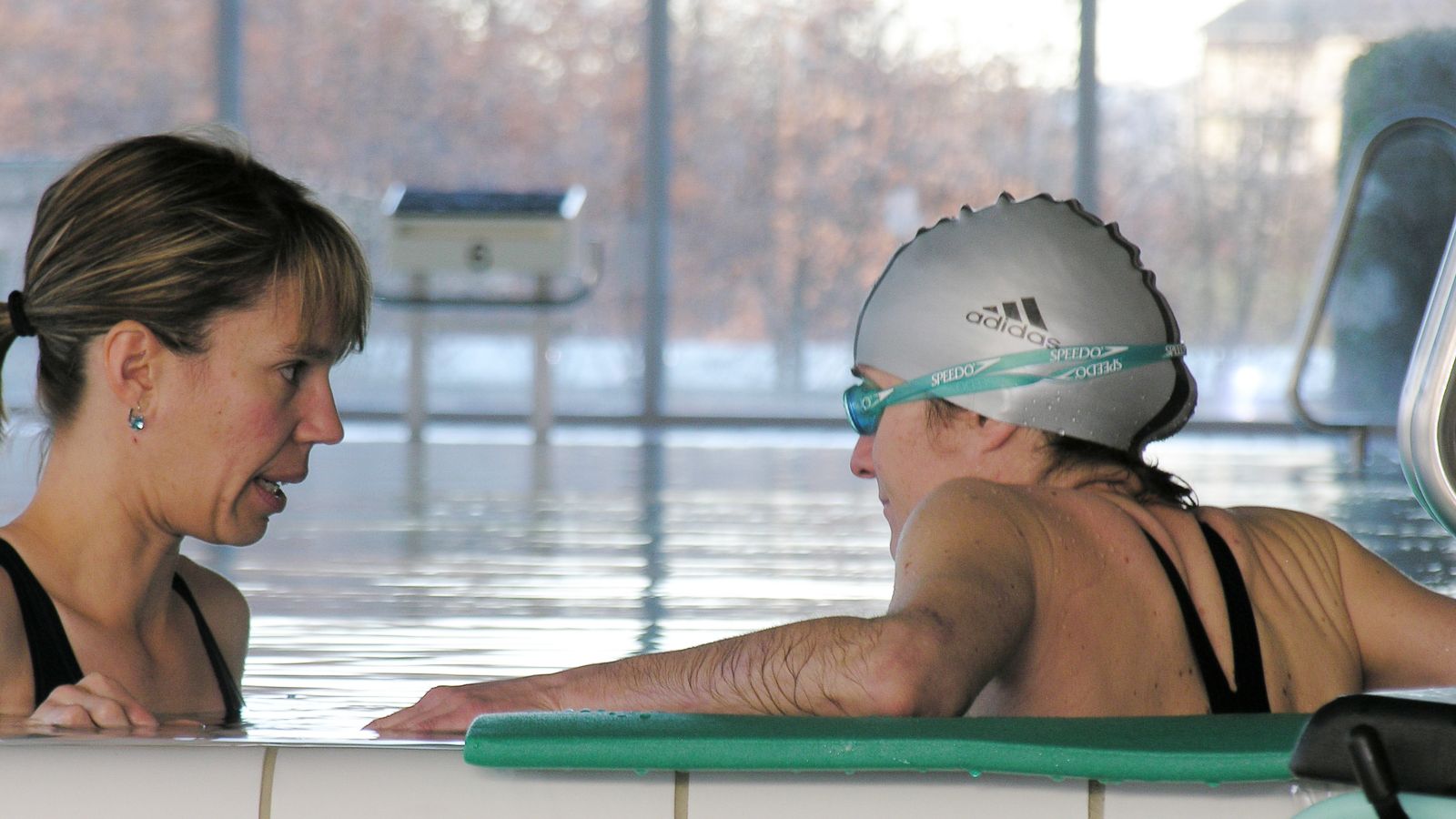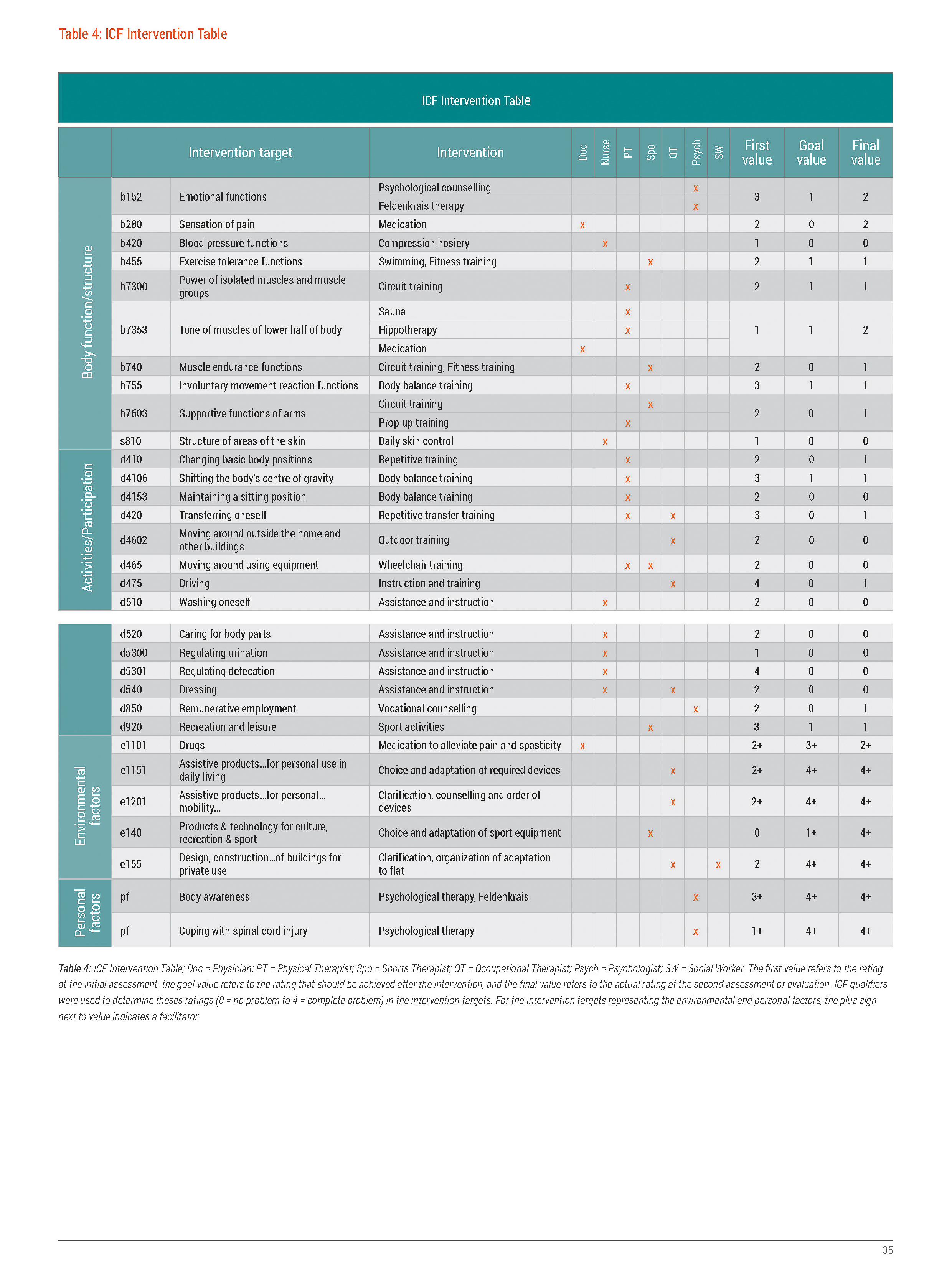Assignment and Intervention

Table 4 depicts the ICF Intervention Table prepared for Lisa's Rehab-Cycle®. The ICF Intervention Table is an overview of all the intervention targets, the interventions themselves and the corresponding rehabilitation team member(s) who is (are) assigned to address each intervention target. See table 4.

Table 4: ICF Intervention Table; Doc = Physician; PT = Physical Therapist; Spo = Sports Therapist; OT = Occupational Therapist; Psych = Psychologist; SW = Social Worker. The first value refers to the rating at the initial assessment, the goal value refers to the rating that should be achieved after the intervention, and the final value refers to the actual rating at the second assessment or evaluation. ICF qualifiers were used to determine these ratings (0 = no problem to 4 = complete problem) in the intervention targets. For the intervention targets representing the environmental and personal factors, the plus sign next to the value indicates a facilitator.
Assigning the Intervention Targets
Interventions in the area of physical therapy and sports are closely related and mutually supportive. In Lisa's case, the physical and sports therapists together implemented interventions to improve Lisa's muscle endurance, foster her athletic abilities and promote the supportive functions of her arms. The physical therapist was also responsible for improving Lisa's overall physical fitness, a prerequisite for participating in almost all types of sports, and for improving Lisa's transferring abilities (together with the occupational therapist) and wheelchair mobility skills (together with the sports and occupational therapists). Reaching a certain level of transferring and wheelchair mobility skills was also essential for being able to participate in sport activities. Therefore repetitive training of various transferring techniques and wheelchair manoeuvring i.e. around and over obstacles was undertaken.
""Interventions in the area of physical therapy and sports are closely related and mutually supportive.""
To improve Lisa’s body balance and overall body movements, body balance training and circuit training were tailored to Lisa's abilities and needs, and integrated into her physical therapy as well as into the group training led by the sports therapist. The sports therapist also employed circuit training to work on strengthening the support functions of the arms, and fitness training and swimming three times a week to increase Lisa’s exercise tolerance.
""Reaching a certain level of transferring and wheelchair mobility skills was also essential for being able to participate in sport activities.""
With guidance from Lisa's sports therapist, a range of sporting activities suitable for Lisa’s injury level and degree of recovery (at the time of initial assessment) were incorporated in her rehabilitation program. For example, basketball was added as part of her fitness training, and Lisa was enrolled in a weekly swimming course. Lisa also took archery lessons four times a week, one of first sport activities that was integrated into rehabilitation programs early on. Based on her initial experiences in participating in sports post-injury, Lisa decided to try out two different types of sports – canoeing and handbike racing. A canoeing test gave her the encouragement to try out a sport that she could share with her boyfriend, and a test of handbike racing potential established Lisa as a promising competitor in the sport. She was extremely enthusiastic about both canoeing and handbike racing.
To help improve the muscle tone in Lisa’s lower extremities, the physical therapist employed hippotherapy. To improve the increasing spasticity, sauna and drug treatment were also implemented.
In order to address the intersecting needs of Lisa’s body functions and her emotional state, the psychologist on her rehabilitation team implemented Feldenkrais therapy – a technique of complementary medicine that utilises body movement for raising body awareness.
Box 2 | A Brief Introduction to the Feldenkrais Method
Movement is life. Life is a process. Improve the quality of the process and you improve the quality of life itself.
Dr. Moshé Feldenkrais
In an effort to compensate for what he perceived as inadequate options for treating his own knee injury, Moshé Feldenkrais, a physicist and electrical engineer, and athlete, developed a method called the “Feldenkrais Method” that aims to heighten self-awareness of the body through movement, while minimizing stress to the body and other limitations to body movement.1314 In simple terms this method involves guiding an individual or a group of individuals through a series of body movements while prompting the individual to sense the differences and nuances between the different body movements, specifically which body movement seems to be most comfortable and require the least effort. Dr. Feldenkrais went on to teach the method to other practitioners.
While not specifically intended as a medical therapy, the Feldenkrais method can help individuals to move more fluidly. The Feldenkrais method has shown to be favourable in balance training, reducing the perceptions of effort, increasing comfort, improving the perceptions of body image, and improving dexterity. There is also some evidence that the Feldenkrais method can be useful in pain management.1415
Two main approaches to the Feldenkrais Method exist:1415
Awareness Through Movement – This is done in a group, in which the Feldenkrais instructor verbally guides the individuals in the group to perform the body movements.
Functional Integration – This is done on an individual basis, in which the Feldenkrais practitioner manually directs the person's body movements.
In addition to the Feldenkrais therapy and the various physical and sports therapeutic interventions, a number of other interventions were integrated in Lisa's rehabilitation program. For example, the nurse provided Lisa with instruction on independent bladder and bowel management, and assisted Lisa to acquire a fitting compression stocking to control her blood pressure. Lisa’s occupational therapist helped support her ability to dress and look after her health, as well as organize and manage the purchase of assistive devices and the adaptations required for her home and car. And psychological counselling was implemented to help alleviate Lisa’s fear of falling, and to support her in coping with the spinal cord injury (SCI).
Although not identified as interventions on Lisa's ICF Intervention Table, several non-sports related recreational and leisure activities were integrated into Lisa’s weekly rehabilitation schedule. This included spiritual guidance, art therapy and Spanish lessons – all of which Lisa enjoyed very much. She particularly liked art therapy, in which she sculpted using clay as a medium.